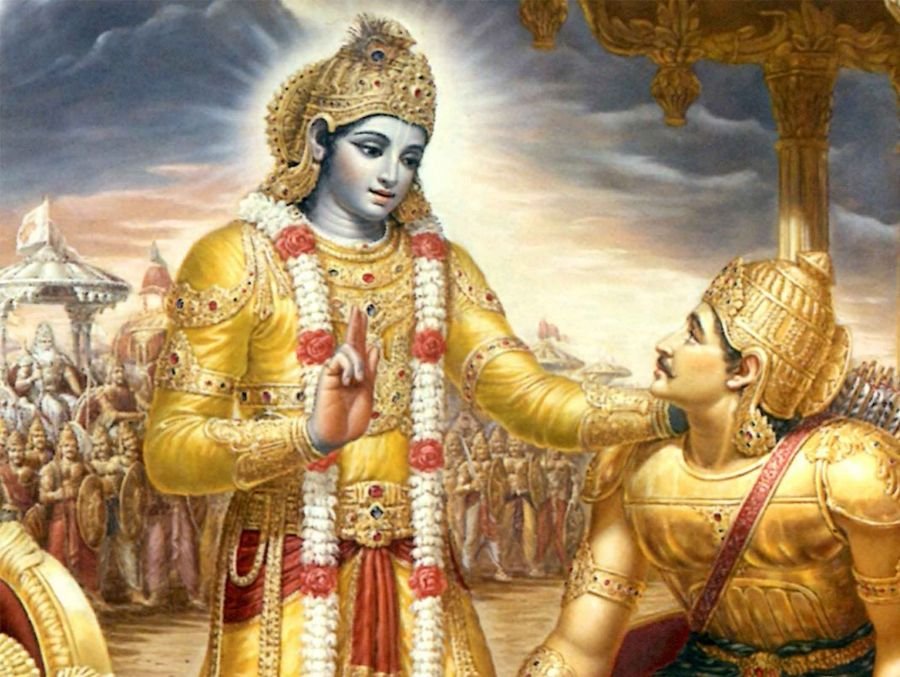(Image Courtesy Mahanidhiswami)
The Divine Is The Source Of All Creation
किरीटिनं गदिनं चक्रहस्त-
मिच्छामि त्वां द्रष्टुमहं तथैव |
तेनैव रूपेण चतुर्भुजेन
सहस्रबाहो भव विश्वमूर्ते || 11.46||
kirīṭinaṁ gadinaṁ chakra-hastam
ichchhāmi tvāṁ draṣhṭum ahaṁ tathaiva
tenaiva rūpeṇa chatur-bhujena
sahasra-bāho bhava viśhva-mūrte|| 11.46||
Shloka Translation
BG – Ch. 11- Ver. 46:
I hope to see you in that four-armed shape, wearing a crown, wielding a mace, disc in hand. Be that very form, O universal form, O one with limitless arms.
Explanation
Arjuna has been shown the cosmic form, which is not visible to the naked eye. Arjuna has discovered that Shree Krishna is much more than just a friend. His heavenly personality spans an infinite number of universes. However, he is uninterested in conducting aiśhwarya bhakti of God Almighty, notwithstanding the endless opulences.
Instead, he chooses to perceive the Almighty Lord in human form, so that he can relate to him as a friend. Arjuna now addresses Lord Krishna as sahastra-baho, which means “thousand-armed one,” and asks to see the chatur-bhuj rūp, or four-armed form of Lord Krishna. Arjuna confirms that Shree Krishna’s four-armed form is identical to his two-armed form by demanding that the Lord manifest in his four-armed form.
Verse & what we can learn
Arjuna requested Shri Krishna to return to his regular form because he was afraid of Shri Krishna’s dreadful shape. It may seem weird to refer to a four-armed person as a regular form. To fully comprehend this request, we must dive deep into the symbolic meaning of the number four. The number four is important in the scriptures because it signifies the four Vedas, four Varnas or classes, four ashrams or stages, and four purushartha or life goals.
During one’s lifetime, they are thought to go through four ashramas, or stages. They begin their lives under the guidance of a guru or instructor, with the sole purpose of learning. Brahmacharya is the name for this stage. They enter the grihastha stage after graduating from school and living as a householder.
They reach a stage where they gradually renounce all material attachments once that is accomplished. This is referred to as vanaprastha. A person’s life culminates at the sanyasa stage after complete renunciation, where the primary goal is spiritual pursuits.
We can discern the importance of numerous facets of the number four in this way. But what Arjuna truly wanted to say to Shri Krishna was that he wanted him to take the shape that his disciples and admirers adored, the form that was the focus of their meditation. This was Shri Krishna’s form as Lord Narayana, which was the personification of calm and tranquillity and the polar opposite of his rudra or horrific appearance, which Arjuna dreaded.
To acquire knowledge and to implement that knowledge in life one needs to be mentally and physically active and healthy and for that daily meditation is a great tool.
There are various types of meditation like Buddhist meditation, heartfulness meditation, mindfulness meditation, meditation for stress, and each meditation benefits are countless. There is also numerous meditation techniques for beginners which help in practicing daily meditation so go ahead and start your journey towards a peaceful and balanced life.
In the next shloka Shri Krishna speaks to Arjuna.
Let’s learn to live with “The Gita” via Meditation Affinity…
